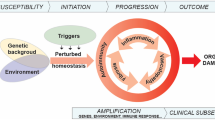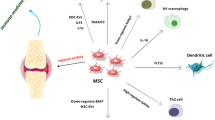Abstract
Objectives
Accumulating evidence have suggested microRNAs (miRNAs) play important roles in the pathogenesis of systemic lupus erythematosus (SLE). Here we aimed to explore aberrant expression of miRNAs in CD4+ T cells from SLE patients and their potential function in SLE pathogenesis.
Methods
First, next-generation sequencing was performed on CD4+ T cells from four SLE patients and three healthy controls (HCs). Candidate miRNAs were then validated in CD4+ T cells from 97 patients with SLE, 16 patients with rheumatoid arthritis, and 12 HCs using qRT-PCR. Then the relationship between the candidate miRNA and clinical characteristics was analyzed. Bioinformatics analysis and validation of the target genes of the candidate miRNA were performed.
Results
A total of 66 upregulated miRNAs and 70 downregulated miRNAs were found between SLE and normal CD4+ T cells samples. miR-199a-3p was identified significant upregulation in the CD4+ T cells of lupus patients. High expression of miR-199a-3p was correlated with several clinical characteristics including low C3 level, positive anti-dsDNA antibody, high ESR level, active lupus nephritis, and active disease activity. When distinguishing active LN from non-LN or active lupus from stable lupus, the AUCs of miR-199a-3p were 0.68 and 0.70, respectively. And the expression of miR-199a-3p, involved in JAK-STAT signaling pathway, was negatively correlated with the STAM expression in CD4+ T cells of SLE.
Conclusion
Our study suggested a novel and promising role of miR-199a-3p in CD4+ T cells for SLE. Further studies are needed to precisely determine the function of miR-199a-3p in this disease.
Key Points • Aberrant expression of miRNAs in CD4+ T cells and their potential function in SLE pathogenesis remained unclear. • miR-199a-3p in CD4+ T cells plays a novel role in the pathogenesis of SLE and serves as a potential target for SLE. |





Similar content being viewed by others
Data availability
All data generated or analyzed in this study are included in this article and its Supplementary materials.
References
Tsokos GC (2011) Systemic lupus erythematosus. N Engl J Med 365(22):2110–2121. https://doi.org/10.1056/NEJMra1100359
Doria A, Gatto M, Zen M, Iaccarino L, Punzi L (2014) Optimizing outcome in SLE: treating-to-target and definition of treatment goals. Autoimmun Rev 13(7):770–777. https://doi.org/10.1016/j.autrev.2014.01.055
Moulton VR, Suarez-Fueyo A, Meidan E, Li H, Mizui M, Tsokos GC (2017) Pathogenesis of human systemic lupus erythematosus: a cellular perspective. Trends Mol Med 23(7):615–635. https://doi.org/10.1016/j.molmed.2017.05.006
Morel L (2017) Immunometabolism in systemic lupus erythematosus. Nat Rev Rheumatol 13(5):280–290. https://doi.org/10.1038/nrrheum.2017.43
Teng X, Brown J, Choi SC, Li W, Morel L (2020) Metabolic determinants of lupus pathogenesis. Immunol Rev 295(1):167–186. https://doi.org/10.1111/imr.12847
Yin Y, Choi SC, Xu Z, Perry DJ, Seay H, Croker BP, Sobel ES, Brusko TM, Morel L (2015) Normalization of CD4+ T cell metabolism reverses lupus. Sci Transl Med 7(274):274ra218. https://doi.org/10.1126/scitranslmed.aaa0835
Berretta F, St-Pierre J, Piccirillo CA, Stevenson MM (2011) IL-2 contributes to maintaining a balance between CD4+Foxp3+ regulatory T cells and effector CD4+ T cells required for immune control of blood-stage malaria infection. J Immunol 186(8):4862–4871. https://doi.org/10.4049/jimmunol.1003777
Moulton VR, Tsokos GC (2015) T cell signaling abnormalities contribute to aberrant immune cell function and autoimmunity. J Clin Invest 125(6):2220–2227. https://doi.org/10.1172/jci78087
Wang Z, Chang C, Lu Q (2017) Epigenetics of CD4+ T cells in autoimmune diseases. Curr Opin Rheumatol 29(4):361–368. https://doi.org/10.1097/bor.0000000000000393
Geng G, Wang H, Xin W, Liu Z, Chen J, Danting Z, Han F, Ye S (2021) tRNA derived fragment (tRF)-3009 participates in modulation of IFN-α-induced CD4(+) T cell oxidative phosphorylation in lupus patients. J Transl Med 19(1):305. https://doi.org/10.1186/s12967-021-02967-3
Schetter AJ, Heegaard NH, Harris CC (2010) Inflammation and cancer: interweaving microRNA, free radical, cytokine and p53 pathways. Carcinogenesis 31(1):37–49. https://doi.org/10.1093/carcin/bgp272
Stypinska B, Paradowska-Gorycka A (2015) Cytokines and MicroRNAs as candidate biomarkers for systemic lupus erythematosus. Int J Mole Sci 16(10):24194–24218. https://doi.org/10.3390/ijms161024194
Carlsen AL, Schetter AJ, Nielsen CT, Lood C, Knudsen S, Voss A, Harris CC, Hellmark T, Segelmark M, Jacobsen S, Bengtsson AA, Heegaard NH (2013) Circulating microRNA expression profiles associated with systemic lupus erythematosus. Arthritis Rheum 65(5):1324–1334. https://doi.org/10.1002/art.37890
Yan L, Jiang L, Wang B, Hu Q, Deng S, Huang J, Sun X, Zhang Y, Feng L, Chen W (2022) Novel microRNA biomarkers of systemic lupus erythematosus in plasma: miR-124-3p and miR-377-3p. Clin Biochem 107:55–61. https://doi.org/10.1016/j.clinbiochem.2022.05.004
Singh RP, Hahn BH, Bischoff DS (2022) Identification and contribution of inflammation-induced novel MicroRNA in the pathogenesis of systemic lupus erythematosus. Front Immunol 13:848149. https://doi.org/10.3389/fimmu.2022.848149
Hochberg MC (1997) Updating the American College of Rheumatology revised criteria for the classification of systemic lupus erythematosus. Arthritis Rheum 40(9):1725. https://doi.org/10.1002/art.1780400928
van der Heijde D, Aletaha D, Carmona L, Edwards CJ, Kvien TK, Kouloumas M, Machado P, Oliver S, de Wit M, Dougados M (2015) 2014 Update of the EULAR standardised operating procedures for EULAR-endorsed recommendations. Ann Rheum Dis 74(1):8–13. https://doi.org/10.1136/annrheumdis-2014-206350
Gladman DD, Ibañez D, Urowitz MB (2002) Systemic lupus erythematosus disease activity index 2000. J Rheumatol 29(2):288–291
Petri M, Orbai AM, Alarcón GS, Gordon C, Merrill JT, Fortin PR, Bruce IN, Isenberg D, Wallace DJ, Nived O, Sturfelt G, Ramsey-Goldman R, Bae SC, Hanly JG, Sánchez-Guerrero J, Clarke A, Aranow C, Manzi S, Urowitz M, Gladman D, Kalunian K, Costner M, Werth VP, Zoma A, Bernatsky S, Ruiz-Irastorza G, Khamashta MA, Jacobsen S, Buyon JP, Maddison P, Dooley MA, van Vollenhoven RF, Ginzler E, Stoll T, Peschken C, Jorizzo JL, Callen JP, Lim SS, Fessler BJ, Inanc M, Kamen DL, Rahman A, Steinsson K, Franks AG Jr, Sigler L, Hameed S, Fang H, Pham N, Brey R, Weisman MH, McGwin G Jr, Magder LS (2012) Derivation and validation of the Systemic Lupus International Collaborating Clinics classification criteria for systemic lupus erythematosus. Arthritis Rheum 64(8):2677–2686. https://doi.org/10.1002/art.34473
Rehmsmeier M, Steffen P, Hochsmann M, Giegerich R (2004) Fast and effective prediction of microRNA/target duplexes. Rna 10(10):1507–1517. https://doi.org/10.1261/rna.5248604
Guo G, Wang H, Shi X, Ye L, Wu K, Lin K, Ye S, Li B, Zhang H, Lin Q, Ye S, Xue X, Chen C (2018) NovelmiRNA-25 inhibits AMPD2 in peripheral blood mononuclear cells of patients with systemic lupus erythematosus and represents a promising novel biomarker. J Transl Med 16(1):370. https://doi.org/10.1186/s12967-018-1739-5
Su X, Ye L, Chen X, Zhang H, Zhou Y, Ding X, Chen D, Lin Q, Chen C (2019) MiR-199-3p promotes ERK-mediated IL-10 production by targeting poly (ADP-ribose) Polymerase-1 in patients with systemic lupus erythematosus. Chem Biol Interact 306:110–116. https://doi.org/10.1016/j.cbi.2019.04.015
Ye H, Su B, Ni H, Li L, Chen X, You X, Zhang H (2018) microRNA-199a may be involved in the pathogenesis of lupus nephritis via modulating the activation of NF-κB by targeting Klotho. Mol Immunol 103:235–242. https://doi.org/10.1016/j.molimm.2018.10.003
Xiong A, Wang J, Mao XL, Jiang Y, Fan Y (2019) MiR-199a-3p modulates the function of dendritic cells involved in transplantation tolerance by targeting CD86. Hla 94(6):493–503. https://doi.org/10.1111/tan.13677
Alunno A, Padjen I, Fanouriakis A, Boumpas DT (2019) Pathogenic and therapeutic relevance of JAK/STAT signaling in systemic lupus erythematosus: integration of distinct inflammatory pathways and the prospect of their inhibition with an oral agent. Cells 8(8). https://doi.org/10.3390/cells8080898
Dang WZ, Li H, Jiang B, Nandakumar KS, Liu KF, Liu LX, Yu XC, Tan HJ, Zhou C (2019) Therapeutic effects of artesunate on lupus-prone MRL/lpr mice are dependent on T follicular helper cell differentiation and activation of JAK2-STAT3 signaling pathway. Phytomedicine 62:152965. https://doi.org/10.1016/j.phymed.2019.152965
Zan H, Tat C, Casali P (2014) MicroRNAs in lupus. Autoimmunity 47(4):272–285. https://doi.org/10.3109/08916934.2014.915955
Tao B, Xiang W, Li X, He C, Chen L, Xia X, Peng T, Peng L, Yang X, Zhong C (2021) Regulation of Toll-like receptor-mediated inflammatory response by microRNA-152-3p-mediated demethylation of MyD88 in systemic lupus erythematosus. Inflamm Res 70(3):285–296. https://doi.org/10.1007/s00011-020-01433-y
Karantanos T, Christofides A, Bardhan K, Li L, Boussiotis VA (2016) Corrigendum: regulation of T cell differentiation and function by EZH2. Front Immunol 7:346. https://doi.org/10.3389/fimmu.2016.00346
You H, Xu D, Zhao J, Li J, Wang Q, Tian X, Li M, Zeng X (2020) JAK inhibitors: prospects in connective tissue diseases. Clin Rev Allergy Immunol 59(3):334–351. https://doi.org/10.1007/s12016-020-08786-6
Banerjee S, Biehl A, Gadina M, Hasni S, Schwartz DM (2017) JAK-STAT signaling as a target for inflammatory and autoimmune diseases: current and future prospects. Drugs 77(5):521–546. https://doi.org/10.1007/s40265-017-0701-9
Ryu H, Kim J, Kim D, Lee JE, Chung Y (2019) Cellular and molecular links between autoimmunity and lipid metabolism. Mol Cells 42(11):747–754. https://doi.org/10.14348/molcells.2019.0196
Mesilaty-Gross S, Reich A, Motro B, Wides R (1999) The Drosophila STAM gene homolog is in a tight gene cluster, and its expression correlates to that of the adjacent gene ial. Gene 231(1–2):173–186. https://doi.org/10.1016/s0378-1119(99)00053-0
Watanabe S, Itoh T, Arai K (1996) JAK2 is essential for activation of c-fos and c-myc promoters and cell proliferation through the human granulocyte-macrophage colony-stimulating factor receptor in BA/F3 cells. J Biol Chem 271(21):12681–12686. https://doi.org/10.1074/jbc.271.21.12681
Dai Y, Huang YS, Tang M, Lv TY, Hu CX, Tan YH, Xu ZM, Yin YB (2007) Microarray analysis of microRNA expression in peripheral blood cells of systemic lupus erythematosus patients. Lupus 16(12):939–946. https://doi.org/10.1177/0961203307084158
Ghadiri N, Emamnia N, Ganjalikhani-Hakemi M, Ghaedi K, Etemadifar M, Salehi M, Shirzad H, Nasr-Esfahani MH (2018) Analysis of the expression of mir-34a, mir-199a, mir-30c and mir-19a in peripheral blood CD4+T lymphocytes of relapsing-remitting multiple sclerosis patients. Gene 659:109–117. https://doi.org/10.1016/j.gene.2018.03.035
Chen R, Alvero AB, Silasi DA, Kelly MG, Fest S, Visintin I, Leiser A, Schwartz PE, Rutherford T, Mor G (2008) Regulation of IKKbeta by miR-199a affects NF-kappaB activity in ovarian cancer cells. Oncogene 27(34):4712–4723. https://doi.org/10.1038/onc.2008.112
Acknowledgements
We thank all patients and healthy donors who participated in this study.
Funding
This research was supported by the Clinical Research Plan of SHDC (SHDC2020CR1015B) to YS and Cultivating Funds of Renji Hospital South Campus, Shanghai Jiaotong University School of Medicine (2016PWGZR05) to GG.
Author information
Authors and Affiliations
Contributions
All authors were involved in drafting the article or revising it critically for important intellectual content, and all authors approved the final version to be published. Dr. Ye had full access to all of the data in the study and takes responsibility for the integrity of the data and the accuracy of the data analysis.
Study conception and design. WH, YS.
Acquisition of data. WH, GG, ZD, HF.
Analysis and interpretation of data. WH, GG, YS.
Corresponding author
Ethics declarations
Disclosures
None.
Ethics approval and consent to participate
The research protocol was approved by the Renji Hospital of Shanghai Jiaotong University School of Medicine. All subjects who participated in this study provided written informed consent.
Consent for publication
Not applicable.
Additional information
Publisher's note
Springer Nature remains neutral with regard to jurisdictional claims in published maps and institutional affiliations.
Supplementary Information
Below is the link to the electronic supplementary material.
Rights and permissions
Springer Nature or its licensor (e.g. a society or other partner) holds exclusive rights to this article under a publishing agreement with the author(s) or other rightsholder(s); author self-archiving of the accepted manuscript version of this article is solely governed by the terms of such publishing agreement and applicable law.
About this article
Cite this article
Wang, H., Geng, G., Zhang, D. et al. Analysis of microRNA-199a-3p expression in CD4+ T cells of systemic lupus erythematosus. Clin Rheumatol 42, 1683–1694 (2023). https://doi.org/10.1007/s10067-023-06534-7
Received:
Revised:
Accepted:
Published:
Issue Date:
DOI: https://doi.org/10.1007/s10067-023-06534-7




